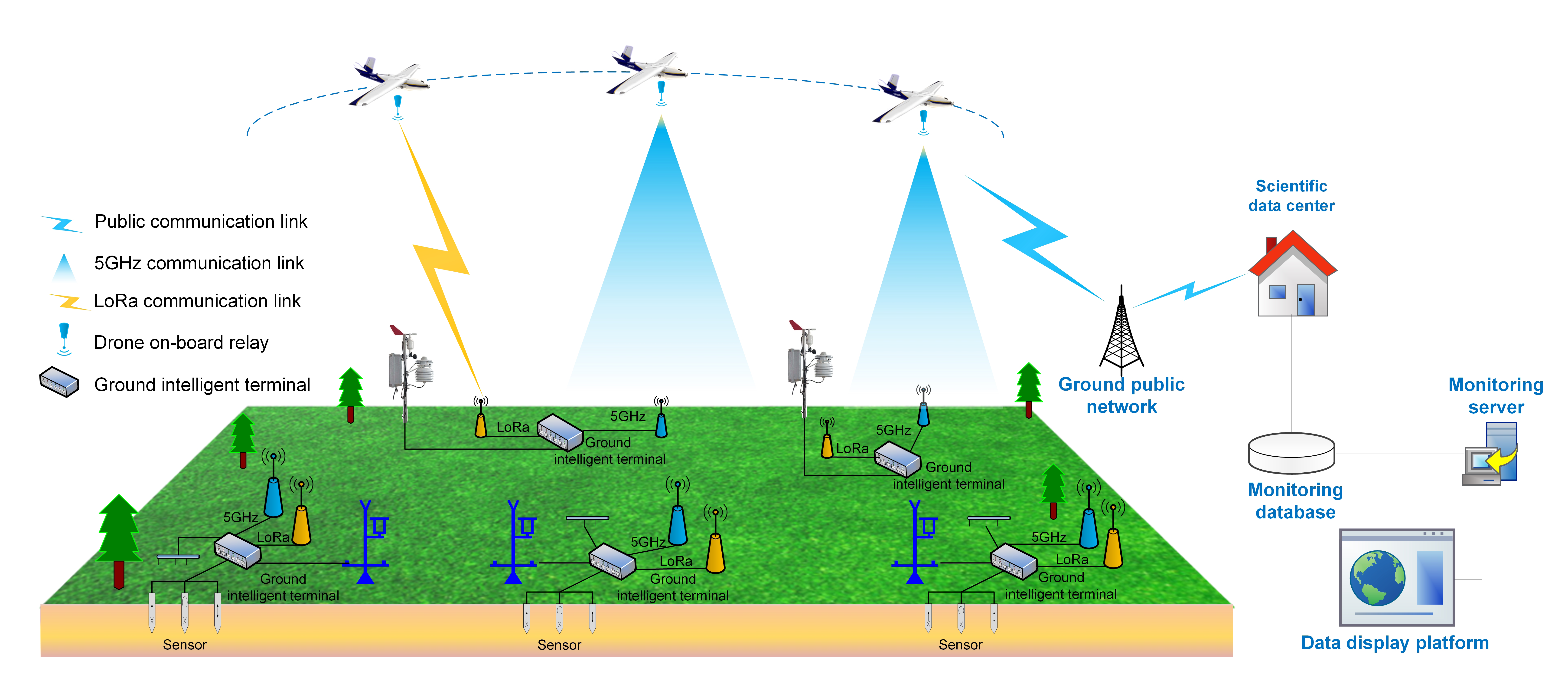The Tibetan Plateau is a vast area with complex terrain, and many areas are not covered by mobile cellular networks such as 4G, so there are still challenges in achieving Internet of Things (IoT) monitoring of these important areas. The drone-enabled IoT relay refers to the drone flying with relay equipment as a communication relay node, establishing a data transmission link with ground IoT equipment to realize high-speed data transmission and forwarding of each IoT terminal. This technology provides an opportunity to achieve environmental monitoring in remote areas without public networks.
Recently, a novel drone-enabled IoT relay system for ecological monitoring is developed and published by the research team led by Prof. LI Xin at the National Tibetan Plateau Data Center, Institute of Tibetan Plateau Research, Chinese Academy of Sciences (CAS), and the CAS Center for Excellence in Tibetan Plateau Earth Sciences, CAS. The system includes a drone on-board relay device for high-speed data transmission and a ground intelligent terminal for intelligent data management, enabling remote collection and transmission of environmental monitoring data in areas not covered by the public network. The core technology is: (1) the use of high-speed 5 GHz wireless communication technology, the data transmission rate of 3.5 MB/s, equivalent to the speed of home broadband, to achieve high-speed collection of monitoring data; (2) the use of long-range (LoRa) technology as a low-power and long-distance wireless communication technology, to send device wake-up commands within 2.5km of the drone's arrival at the environmental monitoring area, and achieve remote wake-up of high-power 5GHz module, which greatly reduces the power consumption of field-deployed equipment and ensures the long-term stable operation of monitoring equipment.

Basic concept of a drone-enabled IoT relay system for environmental monitoring in a remote area without a public network.
As shown in the figure, the system is to achieve environmental monitoring equipment in extremely hard-to-reach areas lacking available public networks, to monitor the surrounding environment in real time and to store monitoring data in real time at ground-based smart terminals. LoRa wireless transmission technology is adopted to wake up the high-power 5 GHz module when the drone enters a region where on-board LoRa can communicate with the ground side. The drones’ on-board relay establishes a high-speed data communication link with the deployed ground intelligent terminal. Then, the drone sends a signal for data collection to the terminal devices and then collects the cached sensor data from the networked node. Once all the data have been received, the drone flies to the next node to perform its data-collection task, returns to its base for offloading stored data, or flies to an area with a public network for forwarding its stored data to the scientific data center through the ground-based public network. This study is important for environmental monitoring and collection of monitoring data in remote or extreme areas that are not covered by public networks, such as the Tibetan Plateau.
The introductory paper of this research was published in IEEE Internet of Things Journal with first author Dr. ZHANG Minghu (Northwest Institute of Eco-Environment and Resources, Chinese Academy of Sciences) and corresponding author Prof. LI Xin (Institute of Tibetan Plateau Research, Chinese Academy of Sciences), entitled as “Drone-Enabled Internet of Things Relay for Environmental Monitoring in Remote Areas Without Public Networks”. The research was supported by the National Key R&D Program of China (Grant No. 2016YFC0500106) and the Strategic Priority Research Program of the Chinese Academy of Sciences (Grant No. XDA20100104).
Full-text available at: https://ieeexplore.ieee.org/document/9069207.
Contact Support
Links
National Tibetan Plateau Data CenterFollow Us

A Big Earth Data Platform for Three Poles © 2018-2020 No.05000491 | All Rights Reserved
|  No.11010502040845
No.11010502040845
Tech Support: westdc.cn